#dissolved oxygen meter
Explore tagged Tumblr posts
Text
DO Meter
Find the best DO Meter JPB-70A for accurate dissolved oxygen measurement. At Uniglobal Business, explore a range of DO meters with pen-type shapes that are mainly designed to help the user carry out on-site operations. For aquatic, environmental, and industrial applications.
0 notes
Text

Labnic Dissolved Oxygen Meter is a compact, robust and easy to use, with a sealed silicone keypad and clear LCD screen that displays results in ppm or mg/L.The Dissolved Oxygen Meter operates on 2 AA batteries (1.5 V). The Dissolved Oxygen Meter features a combined diaphragm cap, allowing for easy replacement of the sensitive membrane by simply screwing on a new cap.
0 notes
Text
Dissolved Oxygen Meter
A dissolved oxygen meter is a handheld or benchtop device used to measure the concentration of dissolved oxygen in water or other liquids. It typically consists of a probe with an oxygen-sensitive electrode and a meter that displays the oxygen concentration in units such as milligrams per liter (mg/L) or parts per million (ppm). Dissolved oxygen meters are widely used in environmental monitoring, aquaculture, wastewater treatment, and research to assess water quality, oxygen levels, and the health of aquatic ecosystems.

0 notes
Text
Reliable Digital & Industrial pH Sensors with Integrated pH Monitoring System
Our advanced pH monitoring system combines precision, durability, and real-time data tracking to meet the needs of modern industrial operations. Featuring both digital pH sensors and industrial pH sensors, this system delivers accurate pH measurements across a wide range of applications including water treatment, chemical manufacturing, pharmaceuticals, and food processing.
The digital pH sensor offers high-resolution measurement and fast response times, with minimal drift for long-term stability. It integrates seamlessly with automated control systems, allowing for continuous pH monitoring and instant alerts in case of deviations. The industrial pH sensor is built to withstand harsh environments, including high temperatures, corrosive chemicals, and high-pressure conditions, making it ideal for demanding field use.

Our complete pH monitoring system provides real-time data visualization, logging, and remote access, helping operators maintain optimal pH levels and improve overall process efficiency. With plug-and-play compatibility and minimal maintenance requirements, it’s a cost-effective solution that enhances quality control and regulatory compliance.
Whether you need precise pH control for a small operation or a complex industrial setup, our digital and industrial pH sensors deliver reliable performance and peace of mind. Upgrade your facility with a trusted pH monitoring system designed for accuracy, durability, and ease of use. WizSensor digital & industrial pH sensor with real-time pH monitoring system for all industries.
#Ammonium sensor#Ammonia nitrogen sensor#Oil in water sensor#Multi-parameter probe#turbidity sensor#Digital pH sensor#Water conductivity meter#chorophyll sensor#optical dissolved oxygen sensor
0 notes
Text
Benchtop Dissolved oxygen meter
The benchtop dissolved oxygen meter is equipped with a backlit LCD display, measuring 135 × 75 mm, ensuring clear visibility of dissolved oxygen readings even in low-light conditions. Its 6-pin mini plug connector guarantees stable and secure connections for accurate dissolved oxygen measurements, enhancing reliability during testing. For power, the meter operates on DC 9 V, utilizing an SC adapter, or alternatively, it can be powered by AC 220 V / 50 Hz, offering flexibility to suit various laboratory setups. With compact dimensions of 210 × 205 × 75 mm and a weight of 1.5 kg, the meter is designed to be portable and space-efficient, facilitating ease of use and storage in laboratory environments.

#laboratory Benchtop Dissolved oxygen meter manufacturer in trapper creek#benchtop dissolved oxygen meter manufacturers in Wrangell#benchtop dissolved oxygen meter manufacturers in sweden
0 notes
Text
youtube
#Probest is an ISO manufacturer#developing and making Dissolved Oxygen Meters#Do Sensor#UVCOD BOD sensors#NH4H sensors#Turbidity Sensors#......#Have assured incoming inspection#process inspection#half-products inspection#end-products inspection#final-before shipping inspection. All products have 100% tested.#Have a reliable partner with assured quality.#hashtag#reliablepartner hashtag#dosensor hashtag#dissolvedoxygenmeters#codprobe hashtag#codsensor hashtag#wateranalyzerinstruments hashtag#waterqualitytest hashtag#turbiditysensors hashtag#turbidityprobe hashtag#turbiditymeters#Youtube
1 note
·
View note
Text
Dissolved Oxygen Meter

A Dissolved Oxygen (DO) Meter is a device used to measure the concentration of oxygen dissolved in a liquid, typically water. This measurement is important in various fields, including environmental monitoring, aquaculture, wastewater treatment, and scientific research. Rack and skid proof shell.
0 notes
Text
portable dissolved oxygen (DO) meter

A portable dissolved oxygen (DO) meter is a device used to measure the amount of dissolved oxygen in a liquid, typically water.Ensure that the meter covers the required range for your specific application. Different environments may have varying levels of dissolved oxygen.This is important in various applications such as environmental monitoring, aquaculture, water treatment, and research.for more visit labtron.us
0 notes
Text
Benchtop Dissolved oxygen meter

Dissolved oxygen range=0-0-to-20-0-mg-l-or-ppm; Dissolved oxygen accuracy=plusmn-0-2-mg-l; Resolution=0-01-mg-l; Calibration points=1-2-points; Sensor type=polarographic-do-probe. Shop Online at Labtron.us
0 notes
Text
Portable Dissolved Oxygen Meters Market
The portable dissolved oxygen meters market refers to the market for handheld or portable devices used to measure the concentration of dissolved oxygen in water. Dissolved oxygen meters are commonly used in various industries and applications, including environmental monitoring, water treatment, aquaculture, and scientific research.
Portable dissolved oxygen meters are the devices that measure dissolved oxygen concentration, temperature, pH, resistivity, and conductivity. These devices are used to measure water quality in various applications including aquariums, aquaculture, pond water, water, and waste water treatment. These are handheld devices that help obtain maximum efficiency in analyzing the water quality and displays minimum and maximum readings.
Inquiry before buying:- https://www.alliedmarketresearch.com/purchase-enquiry/3012
Stringent government regulations for high water quality and rise in concerns regarding presence of harmful acids in water majorly drive the market growth. However, inaccurate reading due to technical faults is expected to hamper the market growth. Rise in awareness regarding microbial infections coupled with various technological advancements are expected to provide lucrative opportunities for the market in the future.

For customization :- https://www.alliedmarketresearch.com/request-for-customization/3012
The key players operating in the market include Hanna Instruments. Inc, Jenco, Hach, OxyGuard, Tayasaf, Fisher Scientific, Mettler Toledo, RBR, Hamilton Company, and WTW.
Portable dissolved oxygen meters typically come with a probe or sensor that is immersed in the water sample, and they provide instant readings of dissolved oxygen levels. They may also offer additional features such as temperature measurement, data logging, and connectivity options for data transfer and analysis.
To obtain the most up-to-date information on the current market conditions, trends, and key players in the portable dissolved oxygen meters market, I recommend referring to industry reports, market research publications, and consulting firms specializing in environmental monitoring and water quality analysis. These sources can provide insights into market size, growth projections, technological advancements, and competitive dynamics in the portable dissolved oxygen meters market. Additionally, it may be helpful to explore trade shows and exhibitions related to environmental monitoring and water quality to stay updated on the latest developments in this field.
Talk to analyst :-https://www.alliedmarketresearch.com/connect-to-analyst/3012
About Us: Allied Market Research (AMR) is a full-service market research and business-consulting wing of Allied Analytics LLP based in Portland, Oregon. Allied Market Research provides global enterprises as well as medium and small businesses with unmatched quality of “Market Research Reports” and “Business Intelligence Solutions.” AMR has a targeted view to provide business insights and consulting to assist its clients to make strategic business decisions and achieve sustainable growth in their respective market domain.
Contact Us: David Correa 5933 NE Win Sivers Drive #205, Portland, OR 97220 United States USA/Canada (Toll Free): +1–800–792–5285, +1–503–894–6022 UK: +44–845–528–1300 Hong Kong: +852–301–84916 India (Pune): +91–20–66346060 Fax: +1(855)550–5975 [email protected] Web: https://www.alliedmarketresearch.com/reports-store/construction-and-manufacturing
#market research#industry#construction#research#global report#Portable Dissolved Oxygen Meters Market
0 notes
Text
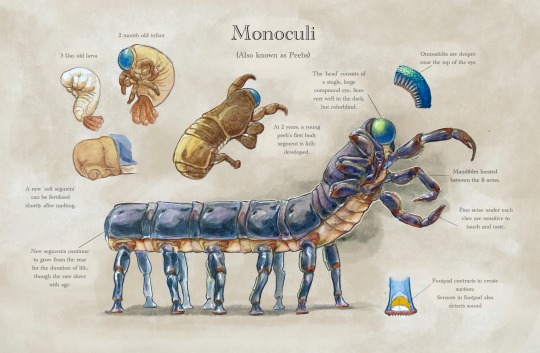
The Monoculi (informally dubbed ‘peebs’) are not exactly a new species from me, but they’ve gone through a pretty drastic redesign since I last posted anything about them. These are a spacefaring species from the same universe as birgworld! Details under the cut.
The Monoculi are so-called for the large compound eye that comprises the “head”. The densely packed ommatidia allow for crisp image resolution, and a variation in the depth of the lenses give the eye a range of acuity from only a few feet along the lower half to hundreds of meters along the top. Monoculi are nocturnal creatures which evolved to navigate complex cave systems by day and tangled branches by night; they have good depth perception and low-light vision but are nearly blind in regular daylight, and cannot perceive color.
The Mono homeworld is peculiar for the presence of a ring, the remnants of two moons which collided early in the planet’s history and bombarded the surface with chunks of space rock long after the planet’s crust had cooled. The result is an unusual abundance of heavy metals in the environment. Iridium, a prohibitively rare mineral on earth, comprises orange-yellow compound which carries oxygen through a Monoculus’s veins. The ring itself also has drastic effects on seasonal surface temperatures, though as on birgworld, life there has adapted accordingly.
Monoculi molt to grow like earth arthropods, but they only do so one segment at a time. A newborn larvae, one of 2 - 5 siblings, will remain soft and aquatic for about 8 months, until it loses its gills and hardens for the first time. They do not begin growing the first proper body segment until the thorax is as large as an adult’s. Molting and mating are both intimately tied to mineral pools found deep in their ancestral cave system. Without them, a molt will invariably fail and lead to severe health complications. Monoculi are hermaphrodites, and mate by pressing the gonopores (small openings under the first pair of arms) against the soft carapace of a first - third instar body segment, fresh after molting. The spawn will bore directly into the segment and trigger its transformation into a reproductive segment, which falls off after young are produced.
These sophonts are relatively large and long lived, with 200+ year old individuals sporting nearly 20 body segments not unheard of. They are also well into their space age, with a once-thriving space tourism industry buckled by a massive recession in recent decades. Rumour has it that several of the abandoned exoplanetary retreats still harbor stranded staff… but the company that built them dissolved and nobody has scraped up to funds for a rescue mission. They avoid contact with other sophonts, with the exception of the swimslugs, with whom they maintain a friendly cultural and technological exchange.
————
Btw, I do still post almost weekly sketches and worldbuilding notes on my patreon
#worldbuilding#speculative biology#peebs#if anyone remembers the ‘friendly myriopod’ post… this is them now
1K notes
·
View notes
Text
DO Meter
Uniglobal Business provides reliable DO Meter JPB-70A is a highly durable, portable, waterproof dissolved oxygen meter, with replaceable polytetrafluoroethylene (PTFE) membrane caps and a protective shield. It has a pen-type shape that is mainly designed to facilitate the user to carry out on-site operations.
0 notes
Text
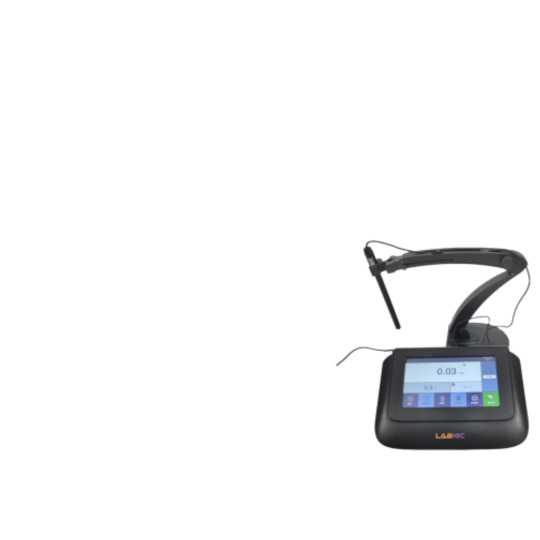
Labnic Dissolved Oxygen Meter is a desktop instrument that measures dissolved oxygen in mg/L, ppm, or % saturation with a water-resistant membrane keypad and a simultaneous temperature display. The Dissolved Oxygen Meter measures parameters including concentration, saturation, and temperature. The Dissolved Oxygen Meter features a wireless Bluetooth connection.
#Dissolved Oxygen Meter Parameters Concentration#Saturation#Temperature#dissolved oxygen electrode#portable dissolved oxygen meter
0 notes
Text
Fish of the Day
Today's fish of the day is the Giant isopod!
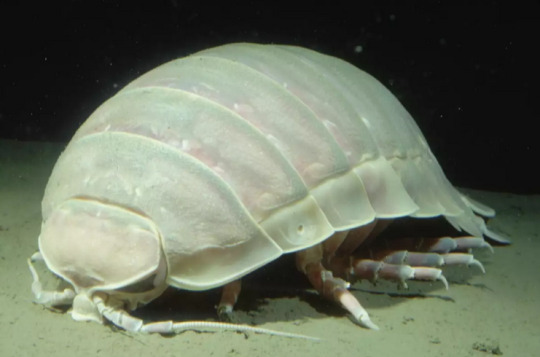
The giant isopod, describes around 20 species in the Bathynomus genus, but most information is based on the Bathynomus giganteus, which is known for being the first giant isopod discovered, and the largest. Giant isopods, as an arthropod, have seven pairs of legs, four jaws, and compound eyes that have over 4,000 facets. The first set of legs is modified into an appendage for grabbing food and bringing it into the mouth, along with attacking prey, and all species with the Bathynomus genus are similar, showing a lack of evolution between populations The full range of this family is unknown, but they can be found around the Indo-Pacific and the Eastern Atlantic ocean. The first time a giant isopod was found and recorded was in 1879 in the Gulf of Mexico, where the largest populations of giant isopods live, with a depth range of 310-2140 meters of depth. Outside of the Gulf of Mexico the other populations have a near identical depth range, and due to their similarity to their close land dwelling cousins, rolly pollies or woodlouse as you might know them, they are one of the textbook examples of deep sea gigantism.
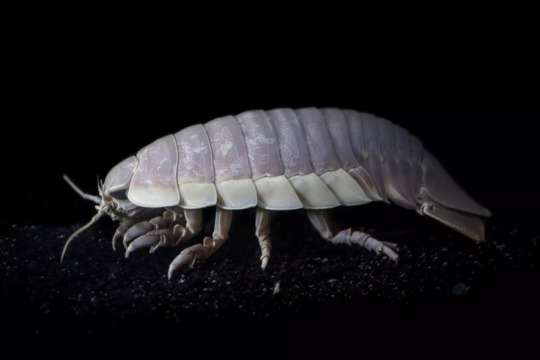
Deep sea gigantism is an observed phenomena where deep sea animals have a habit of getting far larger than their more shallow relatives. Examples of this would be the giant squid, giant sea spider, deepwater stingrays, the bigfin squid,oarfish, and many more. There is currently no encompassing explanation for why this phenomena is so prevalent, but there are multiple theories that have been proven partially correct by different genus. Food scarcity is often referenced, and often thought to be the reason for the giant isopods' large size. as without much food in the deep ocean organisms with the ability to store more food can live for longer periods without prey. Another explanation is the increase in dissolved oxygen, which is often a limiting factor in how large animals can become in their environments. A study of amphipod crustaceans in 1999 discovered their increase in size as the populations found in deeper waters directly increased with the amount of dissolved oxygen. The last and often most damning explanation for deep sea gigantism is the lowered temperature in deeper waters. This one can increase the size in animals by increasing cell size and lifespan, something that can also be found at the world's poles. Deep sea gigantism allows for the giant isopod to get anywhere between 19-36cm (7.5-14.3 inches) in length, with the largest recorded being 20 inches, about the size of a small dog. As compared to their close land relatives, which come in at less than an inch of length.
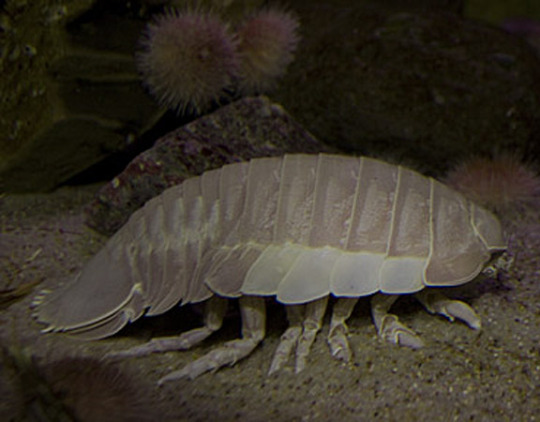
The diet of the deep sea isopod is remarkably similar to that of the land dwelling isopods, as the land dwelling isopods live off of dead or decomposing animals or plant materials. Which is similar to the diet of the giant isopod, which is an essential scavenger and carnivore in the deep. Once believed to be only scavengers, it is now known that giant isopods also actively pursue prey, usually fish, squid, shrimp, crabs, and other deep sea animals they can catch, as shown by a video of an isopod grabbing a dogfish shark and eating its face. These isopods can take down prey several times larger than them, but this may be only when in a confined space, as they don't swim fast and can only attack prey they can catch. But, as scavengers in the deep the giant isopod is primarily known for eating from whalefalls. A whalefall being when the carcass of a dead whale drifts to the deep seafloor, creating huge ecosystem hotspots and specialized animals in deep waters that feed almost exclusively on them. After eating from these whalefalls, giant isopods have been shown to go as long as 5 years in captivity without eating again, and for this reason when in the presence of food they eat far more than their body weight or size, willing to sacrifice locomotion in favor of excess, an easy trade considering they have no natural predators. Despite having no predators, they still have several behaviors similar to land pill bugs, as they can still roll into a ball shape, using their chitin armor to protect themselves, and burrow into the sediment to semi-hibernate.

The reproduction of the giant deep sea isopod is like that of many other arthropods, relying on eggs. In the spring and winter months the isopod females will begin brooding eggs, this is done in a pouch above the stomach and it will store anywhere between 20-30 eggs. During the brooding the female will burrow down into the sediment and refuses to leave until all eggs are hatched, at which point the juveniles are left. Captive isopods eggs measure 13mm in diameter and are thought to possibly be the largest marine invertebrate egg. Once born, these juvenile giant isopods will be as large as 4 inches in length ,and set off on their own in a stage called manca. At this stage, these are almost fully developed giant isopods, lacking only the last pair of legs. These will grow over time, and these animals gain size through molts. Their full lifespan is unknown, but estimated to be decades long, with the age of sexual maturity being unknown but estimated anywhere from 15-18 months.

Have a good day, everybody!

#artropod#giant isopod#deep sea#deep sea giant isopod#isopod#giant#isopods#rolly polly#pill bug#sea creatures#marine life#sea life#fish#fish of the day#fishblr#fishposting#aquatic biology#marine biology#freshwater#freshwater fish#animal facts#animal#animals#fishes#informative#education#aquatic#aquatic life#nature#river
436 notes
·
View notes
Text
Oil in Water & Leak Detection Sensor | Wizse Nsor Inc.
Wizse Nsor Inc. is a trusted provider of advanced sensing technology for environmental and industrial monitoring. Our Oil in Water sensors, Oil Detection sensors, and Oil Leak Detection sensors are engineered to deliver fast, accurate, and reliable results in a wide range of applications including wastewater treatment, offshore drilling, industrial discharge monitoring, and environmental protection.
Our Oil in Water sensors use fluorescence and infrared absorption technologies to detect and quantify trace levels of oil in various water bodies. Whether you need to comply with discharge regulations or prevent environmental damage, our solutions provide the precision and consistency you need.

The Oil Detection and Oil Leak Detection sensors from Wizse Nsor Inc. are ideal for real-time monitoring of pipelines, processing plants, and marine systems. With early warning capabilities, our systems help minimize risk, reduce operational downtime, and ensure regulatory compliance.
We pride ourselves on developing sensors that are rugged, easy to install, low maintenance, and scalable for various industries. At Wizse Nsor Inc., we combine cutting-edge innovation with dependable performance to help safeguard our planet’s water resources.
Choose Wizse Nsor Inc. for intelligent oil sensing solutions—because clean water matters.
#Oil in water sensor#Oil detection sensor#Oil leak detection sensor#dissolve oxygen sensor#dissolved oxygen probe#portable dissolved oxygen meter#optical dissolved oxygen sensor#do sensor
0 notes
Text
It's big, it's strong, its scaly, it's this week's Wet Beast Wednesday topic! An arapaima, also known as a pirarucu or paiche, is any of four species of fish in the genus Arapaima in the order of bony-tongued fish. There is som ongoing debate about the classification of the species, so to keep thing simple, I'm going to use the most common species names of Arapaima gigas (the type species and most well known, and the one with the most confusion about its classification), Arapaima agassizii, Arapaima leptosoma, and Arapaima mapae. Because A. gigas is the most well-studied of the species, unless I say otherwise you can assume everything I say in this post applies to it.

(image: an arapaima)
Arapaimas are bony fish that retain several primitive traits, causing them to sometimes be identified as "living fossils". They are most notable for their size, with A. gigas being a contender for the largest freshwater fish in the world. The maximum recorded size for one was 3.7 meters (10 ft) and 200 kg (400 lbs), but most get to around 2 meters (6.6 ft) long and 200 kg (440 lbs). That average length is decreasing as overfishing of the largest individuals is resulting in a selective pressure for smaller sizes. In addition to their size, they are extremely strong and can move fast if needed. Arapaima are fully capable of leaping out of the water if disturbed or they feel their current pond in unsuitable. Because of their strength, specimens in captivity must be handled with care as they can easy break bones if they slap someone. They live in rivers and lakes in South America, where they are often the top predators.
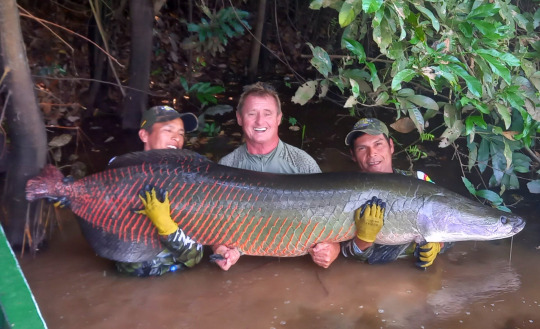
(image: several anglers with an arapaima)
Arapaimas are obligate air-breathers and will drown if they can't get to the surface to breathe. This is accomplished with a specialized swim bladder. The swim bladder is filled with highly vascularized tissue, letting it act like a lung. This pseudo-lung opens into the mouth using a modified gill arch known as the labyrinth organ. Arapaima gills are too small to sustain them, but they can supplement their oxygen intake with the gills. Juveniles are born exclusively using their gills and transition into air-breathers shortly after hatching. Arapaimas can survive up to a full day out of the water. They typically surface to gulp in air every 15-20 minutes. Breathing makes a loud gulping sound that anglers use to target them.
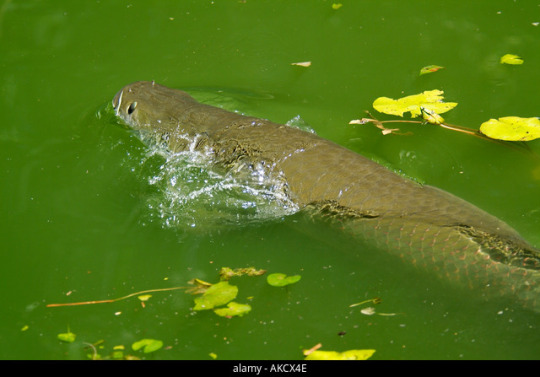
(image: an arapaima at the surface)
Because of their ability to breathe air, arapaimas are top predators in low-oxygen environments. Non-air breathing fish are forced to slow down in water with low levels of dissolved oxygen as they can't get enough oxygen through their gills. Since Arapaimas breathe air, they can easily chase down lethargic smaller fish. They are especially potent predators during the low season, when water levels lower. A combination of rotting vegetation reducing oxygen levels and ponds getting cut off from rivers and losing a supply of oxygen lets the arapaima reign supreme. Arapaimas are primarily predators that feed on smaller fish, though they will hunt other types of animals and eat fruits and seeds. Even land animals aren't safe as arapaimas have been known to launch themselves out of the water to catch animals near the shore. A combination of sharp teeth and their bony tongues are used to debilitate prey.
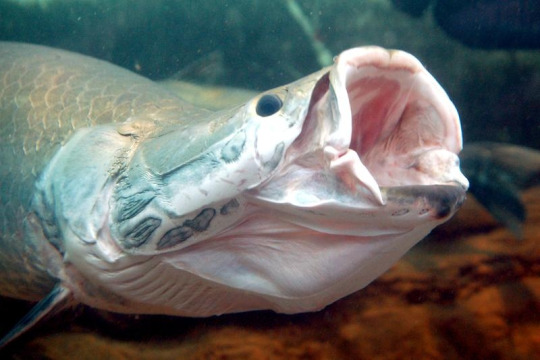
(image: an arapaima with its mouth open)
Not content with powerleveling their attack stat, arapaimas also have excellent defense. Their scales have been compared to bullet proof vests. Each has a hard, mineralized outer layer over multiple layers of collagen fibers. These layers are all oriented at an angle to each other to provide extra strength. This orientation of layers is called a Bouligand-type arrangement and is similar to how plywood is assembled. The harder outer layers and flexible inner layers work together to allow for both strength and flexibility. These scales help provide protection form large predators such as caiman and small threats like biting piranha. They also like provide protection from other arapaima, as the fish are aggressive and will fight each other.

(image: a diagram showing the composition of arapaima scales. source)
You probably wouldn't expect a swimming tank of an animal to be a good parent, but you'd be wrong. Arapaimas work together in mated pairs to build nests for their eggs, then cooperate to guard the nest. Once the eggs hatch, the male will practice mouth brooding, keeping his young safe in his mouth. The female will also help by patrolling the area around the male to ward off predators. They secrete pheromones from their heads to ensure the young don't swim too far away. Eggs are laid either in in the low season or as water levels are starting to rise, ensuring that the young become independent during the high season.
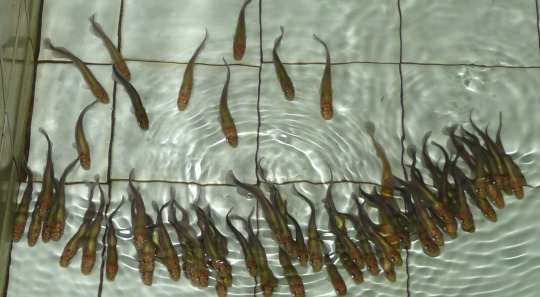
(Image: baby arapaimas)
Arapaima are classified as "data deficient" by the IUCN. This means there isn't enough data to properly assess their conservation needs. They are known to be threatened by overfishing. Arapaima make up a large part of the diet of many South American populations. Habitat loss and pollution are also believed to threaten them. They have been introduced to many areas out of their native range and are an invasive species in placed like Florida, Malaysia, and India.
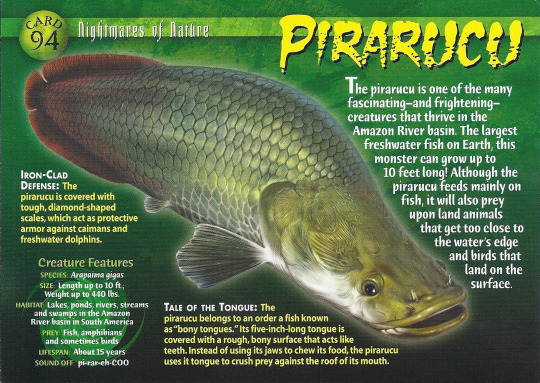
Does anyone else remember these cards? (image: the arapaima card from Weird n' Wild Creatures)
#wet beast wednesday#fishblr#fish#biology#zoology#ecology#animals#aquatic biology#animal facts#absolute unit#arapaima#pirarucu#paiche
1K notes
·
View notes